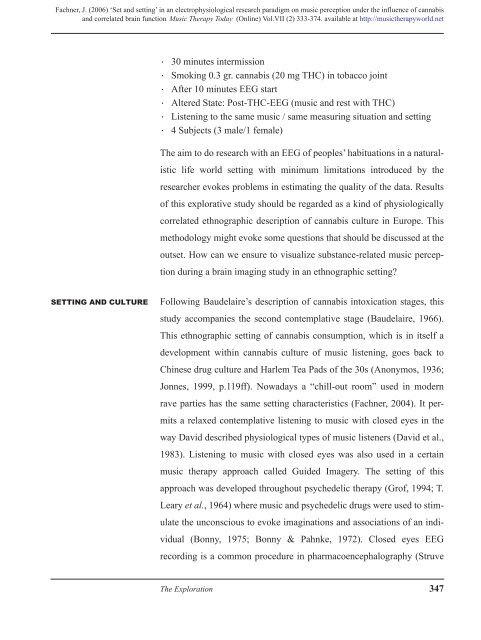Music Therapy Today - World Federation of Music Therapy
Music Therapy Today - World Federation of Music Therapy
Music Therapy Today - World Federation of Music Therapy
You also want an ePaper? Increase the reach of your titles
YUMPU automatically turns print PDFs into web optimized ePapers that Google loves.
Fachner, J. (2006) ‘Set and setting’ in an electrophysiological research paradigm on music perception under the influence <strong>of</strong> cannabis<br />
and correlated brain function. <strong>Music</strong> <strong>Therapy</strong> <strong>Today</strong> (Online) Vol.VII (2) 333-374. available at http://musictherapyworld.net<br />
• 30 minutes intermission<br />
• Smoking 0.3 gr. cannabis (20 mg THC) in tobacco joint<br />
• After 10 minutes EEG start<br />
• Altered State: Post-THC-EEG (music and rest with THC)<br />
• Listening to the same music / same measuring situation and setting<br />
• 4 Subjects (3 male/1 female)<br />
The aim to do research with an EEG <strong>of</strong> peoples’ habituations in a natural-<br />
istic life world setting with minimum limitations introduced by the<br />
researcher evokes problems in estimating the quality <strong>of</strong> the data. Results<br />
<strong>of</strong> this explorative study should be regarded as a kind <strong>of</strong> physiologically<br />
correlated ethnographic description <strong>of</strong> cannabis culture in Europe. This<br />
methodology might evoke some questions that should be discussed at the<br />
outset. How can we ensure to visualize substance-related music percep-<br />
tion during a brain imaging study in an ethnographic setting?<br />
SETTING AND CULTURE Following Baudelaire’s description <strong>of</strong> cannabis intoxication stages, this<br />
study accompanies the second contemplative stage (Baudelaire, 1966).<br />
This ethnographic setting <strong>of</strong> cannabis consumption, which is in itself a<br />
development within cannabis culture <strong>of</strong> music listening, goes back to<br />
Chinese drug culture and Harlem Tea Pads <strong>of</strong> the 30s (Anonymos, 1936;<br />
Jonnes, 1999, p.119ff). Nowadays a “chill-out room” used in modern<br />
rave parties has the same setting characteristics (Fachner, 2004). It per-<br />
mits a relaxed contemplative listening to music with closed eyes in the<br />
way David described physiological types <strong>of</strong> music listeners (David et al.,<br />
1983). Listening to music with closed eyes was also used in a certain<br />
music therapy approach called Guided Imagery. The setting <strong>of</strong> this<br />
approach was developed throughout psychedelic therapy (Gr<strong>of</strong>, 1994; T.<br />
Leary et al., 1964) where music and psychedelic drugs were used to stim-<br />
ulate the unconscious to evoke imaginations and associations <strong>of</strong> an indi-<br />
vidual (Bonny, 1975; Bonny & Pahnke, 1972). Closed eyes EEG<br />
recording is a common procedure in pharmacoencephalography (Struve<br />
The Exploration 347

















